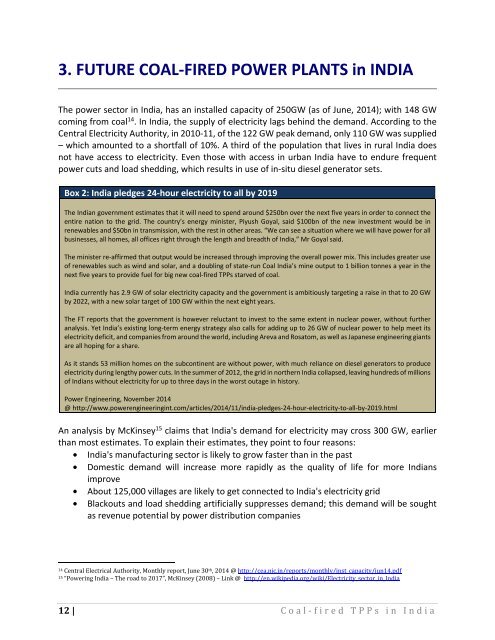Coal Kills
1TndvUf
1TndvUf
Create successful ePaper yourself
Turn your PDF publications into a flip-book with our unique Google optimized e-Paper software.
3. FUTURE COAL-FIRED POWER PLANTS in INDIA<br />
The power sector in India, has an installed capacity of 250GW (as of June, 2014); with 148 GW<br />
coming from coal 14 . In India, the supply of electricity lags behind the demand. According to the<br />
Central Electricity Authority, in 2010-11, of the 122 GW peak demand, only 110 GW was supplied<br />
– which amounted to a shortfall of 10%. A third of the population that lives in rural India does<br />
not have access to electricity. Even those with access in urban India have to endure frequent<br />
power cuts and load shedding, which results in use of in-situ diesel generator sets.<br />
Box 2: India pledges 24-hour electricity to all by 2019<br />
The Indian government estimates that it will need to spend around $250bn over the next five years in order to connect the<br />
entire nation to the grid. The country’s energy minister, Piyush Goyal, said $100bn of the new investment would be in<br />
renewables and $50bn in transmission, with the rest in other areas. “We can see a situation where we will have power for all<br />
businesses, all homes, all offices right through the length and breadth of India,” Mr Goyal said.<br />
The minister re-affirmed that output would be increased through improving the overall power mix. This includes greater use<br />
of renewables such as wind and solar, and a doubling of state-run <strong>Coal</strong> India’s mine output to 1 billion tonnes a year in the<br />
next five years to provide fuel for big new coal-fired TPPs starved of coal.<br />
India currently has 2.9 GW of solar electricity capacity and the government is ambitiously targeting a raise in that to 20 GW<br />
by 2022, with a new solar target of 100 GW within the next eight years.<br />
The FT reports that the government is however reluctant to invest to the same extent in nuclear power, without further<br />
analysis. Yet India’s existing long-term energy strategy also calls for adding up to 26 GW of nuclear power to help meet its<br />
electricity deficit, and companies from around the world, including Areva and Rosatom, as well as Japanese engineering giants<br />
are all hoping for a share.<br />
As it stands 53 million homes on the subcontinent are without power, with much reliance on diesel generators to produce<br />
electricity during lengthy power cuts. In the summer of 2012, the grid in northern India collapsed, leaving hundreds of millions<br />
of Indians without electricity for up to three days in the worst outage in history.<br />
Power Engineering, November 2014<br />
@ http://www.powerengineeringint.com/articles/2014/11/india-pledges-24-hour-electricity-to-all-by-2019.html<br />
An analysis by McKinsey 15 claims that India's demand for electricity may cross 300 GW, earlier<br />
than most estimates. To explain their estimates, they point to four reasons:<br />
• India's manufacturing sector is likely to grow faster than in the past<br />
• Domestic demand will increase more rapidly as the quality of life for more Indians<br />
improve<br />
• About 125,000 villages are likely to get connected to India's electricity grid<br />
• Blackouts and load shedding artificially suppresses demand; this demand will be sought<br />
as revenue potential by power distribution companies<br />
14 Central Electrical Authority, Monthly report, June 30 th , 2014 @ http://cea.nic.in/reports/monthly/inst_capacity/jun14.pdf<br />
15 “Powering India – The road to 2017”, McKinsey (2008) – Link @ http://en.wikipedia.org/wiki/Electricity_sector_in_India<br />
12 | <strong>Coal</strong>-fired TPPs in India




